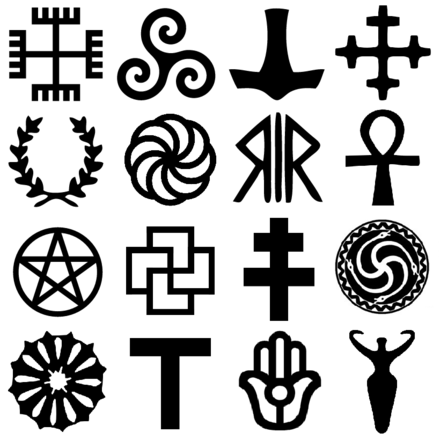
-by Jimmy Akin
“Neopaganism is a movement that has been around for a little more than a century, but it really got rolling in the U.S. only in the last 30 or so years. As the name suggests, a neopagan is a “new pagan.” Hindus and Shintoists would be plain, old, regular pagans since they come from cultures (Indian and Japanese, respectively) that are historically polytheistic. Neopagans come from a historically monotheistic culture (Christian, Jewish, or Muslim) to embrace the worship of more than one god.
Meet the Neopagans
The most common forms of American neopaganism include Wicca, Druidism, Asatru, and Goddess Worship.
Wicca is an alleged revival of a British nature religion involving witchcraft (wicca means magic), though it actually was invented less than a century ago and is not substantively based on any historic British paganism.
Druidism is an alleged revival of another (this time historically real) British paganism, though modern Druidism has very little in common with the historic form. For instance, modern Druids do not generally perform human sacrifice by burning people inside wicker structures or by ritually cutting victims’ throats and leaving their bodies in bogs.
Asatru (sometimes called Odinism, though really Odinism is a subset of Asatru) is an alleged revival of ancient Norse religion. Actually, it has more of a connection with historic Norse religion than the previous two neo paganisms, because we know more about Norse religion. It didn’t die out until Christianity made literacy widespread in northern Europe.
Finally, Goddess Worship is an alleged revival of an ancient goddess-centered religion. It tends to be syncretistic, picking up bits pertaining to the worship of female deities from multiple ancient religions.
There are additional neo-pagan groups as well as many self-styled neopagans who don’t belong to any defined group. Though the actual number of neo-pagans is still quite small, they have achieved a disproportionate status. Wiccans have managed to get approval for Wiccan military chaplains. Even before 9/11, Asatruers got themselves on the FBI’s terrorist watch list because of the militancy of some Odinists. And all you have to do is stroll through the New Age section of any major bookstore to find all kinds of books devoted to Goddess Worship.
Basic Apologetic Strategies
Because neopaganism is a recent phenomenon, apologetics has not yet had the time to prove by experience what strategies are the most effective for reclaiming souls from neopaganism. This problem is exacerbated by the individualistic nature of neopaganism, which requires that very particular evangelization strategies be tailored to the individuals in question. While only those best acquainted with an individual will be able to judge what strategies would be most effective, a number of general approaches may be noted.
-
“Wait and See” Strategy.
Because of the “shock value” aspect of neo-paganism, for many—especially those going through or emerging from teenage rebellion—it is essentially a juvenile fascination.
After the novelty of the shock value wears off, or after the individual matures, his attachment to neo-paganism may fade and he may return to monotheism on his own. For this reason, it may be advisable not to evangelize the neopagan overtly, especially if he is youthful and disinclined to listen to you.
One might wish to make gentle suggestions about the benefits of monotheism or the problems of polytheism. In many cases, it may be necessary simply to pray for the individual and set an example of Christian virtue, charity, and kindness.
-
“Here Are the Positives” Strategy.
If a neopagan proves receptive to monotheism, one might gently, politely, but firmly point out the problems of paganism and the benefits of monotheism.
Such an approach might in some circumstances begin, as did Paul’s speech to the Areopagus (Acts 17), with an acknowledgement of the.aspects of truth reflected in the neopagan’s beliefs. But it must proceed (as did Paul) to a gentle but firm proclamation of the truth of Christianity and the value of monotheism.
This strategy is most likely useful with those neopagans who are already in the process of coming back to Christianity. A few years from now, when there might be more neopagan children than there are now, it may be useful with children leaving the neopaganism of their families and desiring to become part of the Christian ethos around them.
-
“Here Are the Negatives” Strategy.
If the neopagan is hardened and hostile to monotheism, one might forcefully and bluntly point out the problems of paganism.
Though this is a risky strategy and is not likely to bear immediate fruit, it may be the best available option. It is especially risky with neopagans to whom one is related (cf. Matt 13:57).
One way of pointing out the defects of the neopagan position is by pointing out that Europe and surrounding areas were so thoroughly converted to Christianity that no surviving pagan liturgies remain. The deities of European paganism were not able to ensure the survival of their own worship. They lost and lost so badly that neopagans must make up their own liturgies and theologies.
“Why,” one might ask, “should you worship such impotent deities? If they couldn’t protect their former worshipers at the heights of their powers, then how can they be trusted to protect you now?”
One might also pose the question, “Why was it that the followers of the ancient paganisms became Christian in the first place? What was it that they found deficient in paganism that led them to reject it and trust in Christ instead?”
The Nature of the Gods
Many neo-pagans advance the claim that there should not be a single world religion with a single deity or set of deities to be worshiped by all mankind, but rather each group should worship the gods of their ancestors or of their preference.
This claim creates a problem for the neopagan understanding of the gods, and it is fair for the Catholic apologist to point it out. Consider the implications that arise, depending on how the gods were interpreted.
There would seem to be four basic ways of making sense of the claim that different people should worship different pagan pantheons: 1. The gods of different peoples really aren’t different but should be identified with each other (e.g., Zeus = Jupiter = Odin). 2. There are a great many individual gods governing different peoples. 3. The gods are projections created in some sense by the peoples that worship them. 4. The gods are merely symbols or.aspects of something else.
1. If the gods of different religions are to be identified with each other, then it would not seem that there are meant to be different religions among peoples but only different rites used to worship the same set of gods.
This would be especially problematic for Asatruers, who often wish to view their gods as distinct from the gods of other people. A problem for all neo-pagans would be that it is highly implausible that the deities of many pantheons can be identified with each other.
For example, in Greek and Roman paganism, the kings of the gods (Zeus and Jupiter) are in control of thunder, but the thunder god in Germanic paganism is Thor, who is not the king of the gods (that would be Odin). Similarly, in Indo-European paganisms, the sky god tends to be masculine and the earth goddess feminine, but this is reversed in Egyptian mythology. It seems impossible to establish a universal paganism treating each individual pantheon as merely a different expression of the same set of independently real, non-symbolic beings.
2. If the gods of each paganism aren’t to be identified, then there would seem to be multiple deities for every.aspect of nature. Each people will have its own thunder god, its own vegetation god, et cetera. This leads to an implausible situation in a many cases. If Thor controls the thunder in Scandinavia, why should neopagans of Norse descent in America pray to him? Why shouldn’t they pray to an American Indian thunder deity who controls the local thunder? Further, our solar system has only one sun. Just how many sun gods can there be?
3. A theory advanced by some is that the gods are in some sense projections of or creations of their worshipers. If the gods were projections, then today of all days the gods would seem to have only tiny power because of tiny number of their followers. It would be difficult to imagine such beings as worthy of worship.
It also should also be noted that no historic pagans seem to have held this view of their deities. It would seem to be a modern idea—some might even say an intellectually desperate, last-ditch idea—introduced to insulate polytheism from the intellectual problems that otherwise arise for it.
4. Finally, some suppose that the gods do not have independent, objective reality but are just symbols. The question is: symbols of what?
On the one hand, if they are symbols of nature and natural forces, then it is difficult to see why they should be worshiped. Electricity is part of nature, but if one does not worship it when it comes from a light socket, it is difficult to see why one should worship it when one imagines and names a symbolic thunder god to represent it.
Further, the empirical evidence seems to show that the universe itself does not have a mind or a personality. Only by looking beyond nature—to the God who designed nature—can one find transcendent value worthy of worship.
On the other hand, if the answer is given that the gods are symbols of a fundamental spiritual reality that transcends the physical world, then it would seem (since all independent status already has been denied to the gods by rejecting the three alternatives just considered) that one is left with a form of fundamental monotheism that is only cloaked with polytheistic symbols.
That being the case, why should one use the symbols? Why not worship the Creator directly and explore the question of whether he cares for and has spoken to man, as monotheism has historically claimed?”
Love & truth,
Matthew

